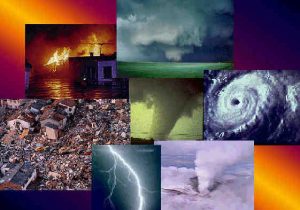 As the fun and sun of summer arrives, so does the threat of many natural disasters. Happenings like earthquakes are always a threat, but floods, wildfires, hurricanes, tornadoes, and such are more apt to strike in the warmer summer months. There are three very important steps you can take to limit the effect natural disasters have on your life and property and expedite your recovery process.
As the fun and sun of summer arrives, so does the threat of many natural disasters. Happenings like earthquakes are always a threat, but floods, wildfires, hurricanes, tornadoes, and such are more apt to strike in the warmer summer months. There are three very important steps you can take to limit the effect natural disasters have on your life and property and expedite your recovery process.
1. Planning.There are some basics that any natural disaster plan should include:
- Always have several escape routes mapped out. Each family member should know where to meet, who to call for help, and where to call to signal their safety to other family members. Your family safety plan should be posted in a central location and the escape route and emergency contact numbers should be reviewed every six months.
- If possible, store irreplaceable items and documents like birth, marriage, death, and divorce certificates; passports; deeds; social security cards; expensive jewelry; and heirlooms in a safety deposit box during high-risk seasons if you live in an area frequently hit by natural disasters. You may also put video or photo documentation, a listing of serial numbers, appraisals, and receipts for these items in your safety deposit box.
- Scan your photos to your computer. You can store your photos with an online storage service or make a CD to place in your safety deposit box.
- You should have an emergency overnight bag ready to go for every person and pet in your family and always keep a credit card, emergency cash supply, and personal identification with you during high-risk seasons.
As far as disaster-specific planning goes, here are some key points:
Flood planning. Many people live in possible flood areas and don’t realize it. For example, those living in areas that recently had a wildfire and those living downstream from a dam could have problems with flash flooding. Those living in or near a construction area could find their risk of flooding increased due to changes in water flow patterns. You can assess your risk of flooding by contacting your local building authority and your insurance agent. Since basements aren’t usually covered by typical flood insurance policies, those with a basement need a plan on moving their valuables to upper-levels. Do make sure that you have an escape plan, as discussed above, in place for your family.
Hurricane planning. Most people in areas prone to hurricanes are already on high alert during hurricane season, but do keep in mind that hurricanes and the stormy remnants are often unpredictable. The flood planning from above is applicable to hurricane planning. Additionally, you’ll want to have a supply of nails and plywood ready to go so that you can board-up your home before evacuation. Remember, if your local authorities issue an evacuation, then you need to heed it.
Wildfire planning. Wildfires can begin unnoticed and spread rapidly with little forewarning. An effective evacuation plan is vital in many cases. If you do have forewarning, then stay tuned to the emergency broadcasts and follow the evacuation directions from local authorities. Remember to take your emergency evacuation bag with you.
If you’re under a warning, but haven’t been advised to evacuate yet, then you might have time to turn off your gas lines and propane tanks, soak your roof and shrubs with water, move flammable furniture to the center of rooms, and move large valuables to the safest location possible.
Tornado planning. Unlike many other disastrous events, leaving your home during a tornado warning is seldom a wise move. Everyone in your family should know where they should go during a tornado warning. While a basement is ideal, not everyone has one. You can use a central room; preferably one that doesn’t have windows or overhead objects. Be sure your emergency kit and phone numbers are in your designated room.
Earthquake planning. Follow the directions from tornado planning. You might also want to place an emergency kit in your vehicle and at your place of employment. Check to make sure your child’s school is also well-prepared.
2. Prevention
- Aside from living in an area not prone to natural disasters, there isn’t much you can do to avoid them. However, unlike most other natural disasters, wildfires can sometimes be prevented. You can personally prevent fires by being careful when using open flames, maintaining your chimney flue, and not throwing cigarettes outdoors. Of course, wildfires can happen regardless of your personal care with fire.
- You can help to prevent flames from impacting your home by creating a defensible space. In fact, some insurers are now inspecting properties for defensible space before issuing or renewing policies. Your insurance agent, local agricultural organizations, and federal agencies like the American Red Cross and FEMA are valuable information sources on creating defensible spaces. The damage of flooding can also be limited by planning water diversions and landscaping as protective devices.
3. Insurance
- Last, but certainly not least, you should make sure your existing insurance is providing adequate protection. For example, your regular Homeowners policy most likely won’t provide coverage if a boulder falls or rolls into your home since such would be considered an earth movement and need to be covered by Earthquake insurance. Another example would be your regular Homeowners policy not covering damage from a water or sewage system outside your home breaking, or damages from a flash flood, as these would fall under Flood insurance. If you obtain Flood insurance, keep in mind that the coverage won’t become effective for 30 days and your basement usually still won’t be covered.





